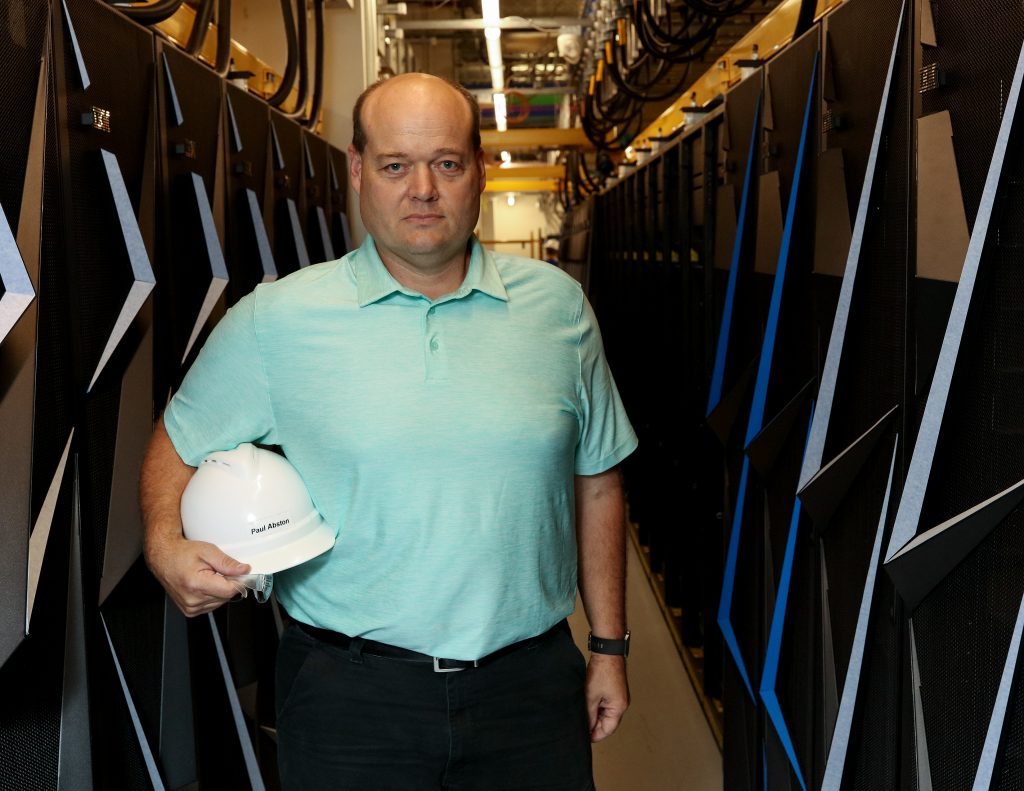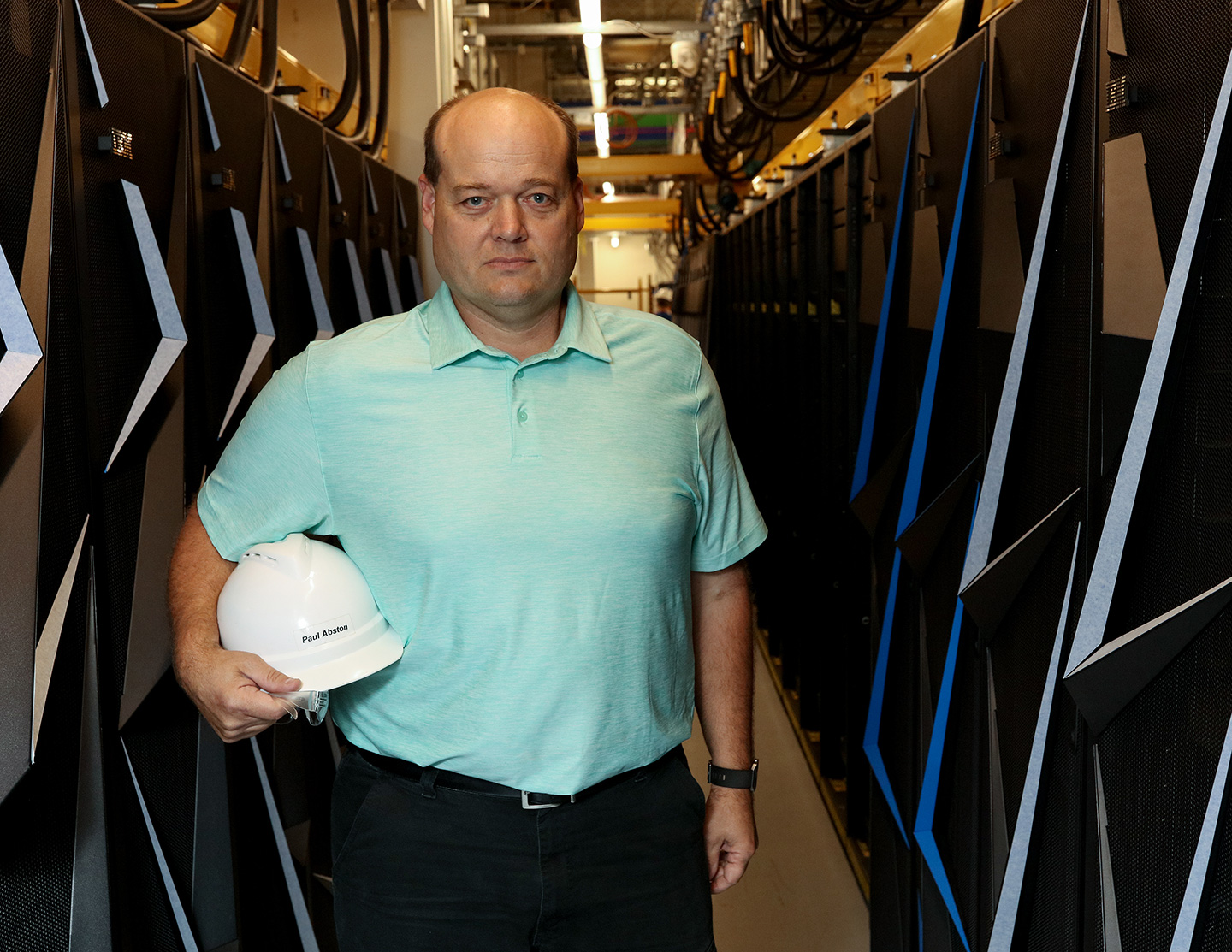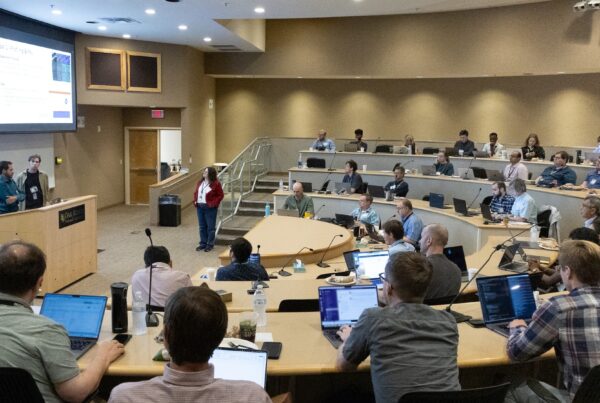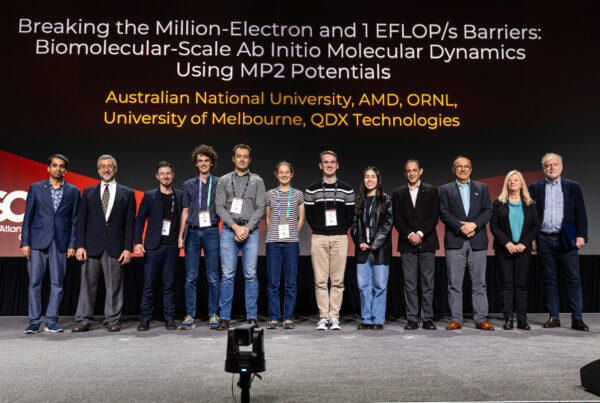
Paul Abston, the safety and installation manager of the Summit supercomputer, brings more than 20 years of experience as a safety professional to the job.
The Faces of Summit series shares stories of the people behind America’s top supercomputer for open science, the Oak Ridge Leadership Computing Facility’s Summit. The IBM AC922 machine launched in June 2018.
Every job brings its own potential hazards—even supercomputer installations. So when the Oak Ridge Leadership Computing Facility (OLCF), a US Department of Energy (DOE) Office of Science User Facility located at Oak Ridge National Laboratory (ORNL), started planning the installation phase of its next leadership-class supercomputer, Summit, the center sought a safety expert to help ensure a smooth setup.
Paul Abston, a longtime ORNL safety professional, answered the call. With more than 20 years of experience in identifying and navigating job site hazards, Abston made a natural fit for leading the safety and logistical aspects of standing up Summit.
As the Summit safety and installation manager, Abston spends much of his time coordinating daily activities among multiple project stakeholders. Communication is key, as installation teams of various backgrounds and nationalities share the same dynamic work space. While one team is setting up Summit’s high-speed storage network, another may be adjusting the system’s electrical components. With all the activity, it could be easy for safe work habits to take a back seat.
“My job is to make sure we all understand everyone’s scope every day—who needs what space and who will be working where,” Abston said. “If we accomplish what we need to accomplish safely and correctly, the rest will take care of itself.”
Abston began this task with by envisioning what could go wrong. Working with lead Summit vendor IBM, he developed a job hazard analysis that identified potential hazards workers may encounter during each step of the installation. Sharing the plan with workers puts them a step ahead of accidents. Additionally, Abston encourages workers to report any hazards they see onsite.
“Executing projects and performing work safely are of the utmost importance to the OLCF and its stakeholders,” said OLCF project director Buddy Bland. “Paul brings a wealth of safety knowledge and experience to our organization, working closely with ORNL crafts, construction subcontractors, and IBM technical teams to ensure safe completion of their respective activities.”
Since August, Abston has overseen the delivery and installation of several hundred server cabinets on the floor of Summit’s computer room within the ORNL Computational Sciences Building. Each cabinet had to be quickly and efficiently unloaded, moved to the computer room, and connected to the building infrastructure.
Now the installation has progressed to Summit’s “brain”—the thousands of processors, switches and management infrastructure that will provide the unprecedented computer power needed for breakthrough science.
The path to safety
Abston has been advancing ORNL’s safety culture since the early 1990s. The Crossville, Tennessee, native first came to ORNL to assist with long-term nuclear waste remediation. At times, the work called for him to strap on double layers of personal contamination clothing. Safety became a formal part of his role after the Occupational Safety and Health Administration implemented new standards to govern environmental clean-up activities.
“I was an environmental technician performing sampling in areas that needed cleanup,” Abston said. “When the new standard was implemented, you had to have a health and safety officer on the job. I was doing my own monitoring and already had the skill set. From that point forward, I became the health and safety guy.”
In the years that followed, Abston augmented his on-the-job knowledge with formal education. After starting his career with an associate’s degree, he tacked on a bachelor’s and a master’s, and became a certified safety professional.
Abston left ORNL for a spell in 2000 to do environmental cleanup for another DOE contractor. He returned 8 years later to lead construction safety at the lab and later contributed to safe operation of the target facility at ORNL’s Spallation Neutron Source. When the opportunity to lead the Summit installation presented itself, Abston said he saw an opportunity for a new challenge.
“This became a stretch role that intrigued me a lot,” he said. “It is unlike any other job I’ve ever done.”
Keeping it green
In addition to making sure the Summit installation is a safe operation, Abston is also working to ensure it is a green one.
As truckloads of new computing parts arrive, a steady flow of packing materials must be diverted out of the facility and into the proper recycling or waste stream. Limited storage space adds extra urgency to the task. During the peak period of cabinet deliveries, Abston’s team managed to unload, unpack, and position around ten cabinets in an hour. To cut down on particulate matter in the computer room—a potential problem for Summit’s air-cooled components—packing materials had to be removed and discarded outside the room.
By the time the project is complete, Abston estimates his team will have handled more than 1,500 wood pallets, along with pickup-size piles of cardboard, packing foam, and scrap metal. Each day, the arrival of ten new cabinets means another truckload of cardboard to offload.
“To keep the environment present in what we’re doing, we are recycling everything that we can in large volume,” Abston said.
The Faces of Summit series shares stories of people working to stand up America’s next top supercomputer for open science, the Oak Ridge Leadership Computing Facility’s Summit. The next-generation machine is scheduled to come on line in 2018.
Oak Ridge National Laboratory is supported by the US Department of Energy’s Office of Science. The single largest supporter of basic research in the physical sciences in the United States, the Office of Science is working to address some of the most pressing challenges of our time. For more information, please visit science.energy.gov.






